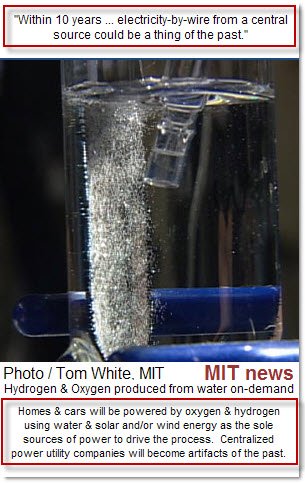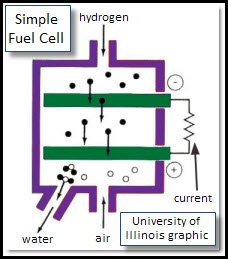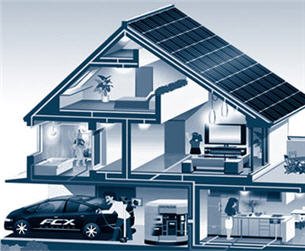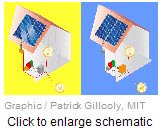Hydrogen Is Breaking Out
November 11, 2019
New catalyst efficiently produces hydrogen from seawater
"... The researchers tested the catalysts with seawater drawn from Galveston Bay off the Texas coast. Ren, M.D. Anderson Chair Professor of physics at UH, said it also would work with wastewater, providing another source of hydrogen from water that is otherwise unusable without costly treatment.
"Most people use clean freshwater to produce hydrogen by water splitting," he said. "But the availability of clean freshwater is limited ...
"Seawater is one of the most abundant resources on earth, offering promise both as a source of hydrogen - desirable as a source of clean energy - and of drinking water in arid climates. But even as water-splitting technologies capable of producing hydrogen from freshwater have become more effective, seawater has remained a challenge.
"Researchers from the University of Houston have reported a significant breakthrough with a new oxygen evolution reaction catalyst that, combined with a hydrogen evolution reaction catalyst, achieved current densities capable of supporting industrial demands while requiring relatively low voltage to start seawater electrolysis.
"Researchers say the device, composed of inexpensive non-noble metal nitrides, manages to avoid many of the obstacles that have limited earlier attempts to inexpensively produce hydrogen or safe drinking water from seawater. The work is described in Nature Communications."
Full article: New catalyst efficiently produces hydrogen from seawater
BACKUP to above article: Researchers Produce Hydrogen From Sea Water in ‘Clean Energy’ Breakthrough
Nature Communications volume 10, Article number: 5106 (2019)
Published: November 8, 2019
Citation
"Abstract
"Seawater is one of the most abundant natural resources on our planet. Electrolysis of seawater is not only a promising approach to produce clean hydrogen energy, but also of great significance to seawater desalination. The implementation of seawater electrolysis requires robust and efficient electrocatalysts that can sustain seawater splitting without chloride corrosion, especially for the anode. Here we report a three-dimensional core-shell metal-nitride catalyst consisting of NiFeN nanoparticles uniformly decorated on NiMoN nanorods supported on Ni foam, which serves as an eminently active and durable oxygen evolution reaction catalyst for alkaline seawater electrolysis. Combined with an efficient hydrogen evolution reaction catalyst of NiMoN nanorods, we have achieved the industrially required current densities of 500 and 1000?mA?cm-2 at record low voltages of 1.608 and 1.709V, respectively, for overall alkaline seawater splitting at 60°C. This discovery significantly advances the development of seawater electrolysis for large-scale hydrogen production."
August 10, 2008

New catalyst materials abundant, cheap, non-toxic
'Major discovery' from MIT primed to unleash solar revolution
Batteries NOT required
"Within 10 years ... electricity-by-wire from a central source could be a thing of the past ...
"MIT researchers have overcome a major barrier to large-scale solar power: storing energy for use when the sun doesn't shine. Daniel G. Nocera, the Henry Dreyfus Professor of Energy at MIT, has developed a simple method to split water molecules and produce oxygen gas, a discovery that paves the way for large-scale use of solar power ...
"Requiring nothing but abundant, non-toxic natural materials, this discovery could unlock the most potent, carbon-free energy source of all: the sun. 'This is the nirvana of what we've been talking about for years,' said MIT's Daniel Nocera, the Henry Dreyfus Professor of Energy at MIT and senior author of a paper describing the work in the July 31 issue of Science. 'Solar power has always been a limited, far-off solution. Now we can seriously think about solar power as unlimited and soon.'
"Inspired by the photosynthesis performed by plants, Nocera and Matthew Kanan, a postdoctoral fellow in Nocera's lab, have developed an unprecedented process that will allow the sun's energy to be used to split water into hydrogen and oxygen gases. Later, the oxygen and hydrogen may be recombined inside a fuel cell, creating carbon-free electricity to power your house or your electric car, day or night ...
"Currently available electrolyzers, which split water with electricity and are often used industrially, are not suited for artificial photosynthesis because they are very expensive and require a highly basic (non-benign) environment that has little to do with the conditions under which photosynthesis operates ...
"The key component in Nocera and Kanan's new process is a new catalyst that produces oxygen gas from water; another catalyst produces valuable hydrogen gas. The new catalyst consists of cobalt metal, phosphate and an electrode, placed in water. When electricity -- whether from a photovoltaic cell, a wind turbine or any other source -- runs through the electrode, the cobalt and phosphate form a thin film on the electrode, and oxygen gas is produced ...
"The new catalyst works at room temperature, in neutral pH water, and it's easy to set up ...
"Nocera hopes that within 10 years, homeowners will be able to power their homes in daylight through photovoltaic cells, while using excess solar energy to produce hydrogen and oxygen to power their own household fuel cell. Electricity-by-wire from a central source could be a thing of the past ...
"The success of the Nocera lab shows the impact of a mixture of funding sources - governments, philanthropy, and industry. This project was funded by the National Science Foundation and by the Chesonis Family Foundation, which gave MIT $10 million this spring to launch the Solar Revolution Project, with a goal to make the large scale deployment of solar energy within 10 years."
Source: MIT, 'Major discovery' from MIT primed to unleash solar revolution: Scientists mimic essence of plants' energy storage system
• Daniel Nocera describes new process for storing solar energy
in this video on MIT TechTV
• Daniel Nocera forms Sun Catalytix / From the linked article, "Commercial 'electrolyzers' already exist that can split water, but they are expensive. Nocera’s team is looking to create something very cheap that is made of PVC plastic. In the end, Nocera wants to have a full system. "The idea is to use solar panels to power the electrolyzer to produce hydrogen which would be stored in tanks. When people need electricity, the stored hydrogen would put through a fuel cell." -- Source: Clean Technica
• Coming Soon: $20 'Solar to Hydrogen' Conversion System / From the linked article, "The system works by utilizing solar energy to split water into hydrogen and oxygen. The hydrogen is then stored to be used later. While there is nothing new in this technology, the way in which the the system does these things is completely revolutionary. The system can use water from any source, be it river water, sea water or even waste water. The company claims to that the system is highly efficient and is capable of powering a house with only two bottles of water from 'any source'." -- Source: Clean Technica
• Sun Catalytix / website
• Clean Technica / clean energy or cleantech news site
• Google: mit hydrogen oxygen fuel cell
August 17, 2008

On-demand power from water ...
Anorak fabric a boost for fuel cells
... requires hydrogen/oxygen and fuel cells
"Bjorn Winther-Jensen, of Monash University, said the synthetic fabric Gore-Tex had revolutionised outdoor clothing, and his team's Gore-Tex-based electrode could do the same for fuel cells, which generate electricity from hydrogen and oxygen.Fuel Cell Basics
"'The same way as waste vapour is drawn out of this material to make hikers more comfortable, so it is able to breathe oxygen into our fuel cell and into contact with the conductive plastic,' Dr Winther-Jensen said.
"Platinum is a key ingredient in fuel cell electrodes, but world reserves would meet less than 20 per cent of demand if all cars were to be hydrogen run.
"The Australian-made electrode was as efficient as a platinum electrode, but much cheaper, he said. 'Platinum is about $2000 per ounce and ours is about $2000 a kilo.' The Australian advance, which involves depositing a layer of electrically conducting plastic about one-100th the thickness of a human hair onto the Gore-Tex, is published in the journal Science.
"It might be five years before the technology can be used in car fuel cells ..."
Source: Anorak fabric a boost for fuel cells, Deborah Smith Science Editor, smh.com.au, August 1, 2008
• More fuel cell news:
Cheaper Hydrogen Fuel Cells: Utility of Non-Precious-Metal Catalysts Documented excerpt below ...
"In a paper published April 21 [2011] in Science, Los Alamos researchers ... describe the use of a platinum-free catalyst in the cathode of a hydrogen fuel cell ... Polymer-electrolyte hydrogen fuel cells convert hydrogen and oxygen into electricity ... The catalysts -- which use carbon (partially derived from polyaniline in a high-temperature process), and inexpensive iron and cobalt instead of platinum -- yielded high power output, good efficiency, and promising longevity ... the carbon-iron-cobalt catalyst fuel cells effectively completed the conversion of hydrogen and oxygen into water, rather than producing large amounts of undesirable hydrogen peroxide. Inefficient conversion of the fuels, which generates hydrogen peroxide, can reduce power output by up to 50 percent, and also has the potential to destroy fuel cell membranes ... the carbon- iron-cobalt catalysts ... create extremely small amounts of hydrogen peroxide, even when compared with state-of-the-art platinum-based oxygen-reduction catalysts."
• What is a fuel cell? / Princeton University
• How Fuel Cell Vehicles Work / Energy Efficiency and Renewable Energy
• Fuel Cell Animation / eere
From: David Sadler
Sent: Saturday, February 09, 2008 4:29 PM
To: Dave Powelson
Subject: hydrogen is breaking out
Dave,
Spent a few hours yesterday and today looking at what’s new (things I didn’t know about) with hydrogen.
FUEL CELLS

Image: HydroCar by Horizon Fuel Cell Technologies
Check out Horizon Fuel Cell's Hydrocar toy. It requires NO batteries to begin the electrolysis and converts the Hydrogen into electricity to run the car using a reversible Polymer Electrolyte Membrane (PEM). "The kit's fuel cell unit combines water electrolysis and fuel cell functions into one device." Just add water. Download the brochure from the page. The toy car has an onboard solar module that powers the electrolysis.
Horizon’s h-racer uses hydrogen too. It’s electrolysis is powered by a mini-solar panel. This toy h-racer was the #1 selling hydrogen device in the world last year (2007). It won the following awards: Silver Award from the Business Week International Design Excellence Awards and Best Inventions of 2006 by Time Magazine.
• Horizon Fuel Cell Hydrocar.
• Horizon Fuel Cell H-Racer
• Horizon Fuel Cell Technologies
Think Big / Start Small
HOME POWER STATIONS

Image: Honda Motors showing a drawing of the Home Energy Station powering the entire home and fueling a hydrogen powered car. Note the home is roofed in solar panels. |

Image: by EcoGeek.org of PURE Energy Centre's HyPOD powered by 2 x 65watt Proven Energy wind turbines. The HyPOD produces hydrogen through electrolysis. This hydrogen then powers PURE Energy's facilities and automobiles. See their Unst Renewable Energy (PURE) Project pdf document of the project. See also: American Wind Energy Association (AWEA) |
Then Honda got my attention with their Home Energy Station. Currently, it uses natural gas, but the Hydrocar demonstrates this can be done with solar. Then the PURE Energy Centre's HyPOD is a working commercial device that uses solar, wind or wave to power the generation of hydrogen from water. More on all this below.
What I like about Honda’s HES is how they, as a major car manufacturer, are trying to bring hydrogen cars to the mass market by providing home based filling stations. They are just using metered natural gas when they could be using free and renewable solar, wind or wave as does the HyPOD.
Check the Honda Home Energy Station out here.
Honda FCX – Official Site
... and read all four panels.
Take special note of panel 4!
The Home Energy Station
The Home Energy Station, which generates hydrogen from natural gas, is designed to provide heat and electricity for the home through fuel cell c-generation and to supply fuel for a hydrogen-powered fuel cell vehicle.
• Fuel Cell Markets / Building partnerships to take hydrogen and fuel cells to market
Then there’s this for full sized cars. I see that water4gas is listed here at #2.
Why Waste Money On High Price Gas? Convert Your Car To Run With Water...
articleanswer.com
Last Updated: 2/8/2008
"Welcome to the Water Fuel-Kit Reviews and Web Directory. Whether you're trying to save money on gas or just help the environment by cleaning your vehicle's emissions, converting your car to run on water (as a supplement to gasoline) provides the lowest-cost, safest, and most rewarding solution. The technology to run cars on H2O (derived from water) is proven, but the information to do so is usually expensive and hard to find. Plus, it's difficult to know which information to trust!
"So Which water-fuel conversion kit manual is best? There are several factors to consider in picking the best conversion kit guide. The first factor is whether the technology works. There are a number of conversion plans floating around the internet that either don't work, or are extremely difficult to understand. However, other guides we reviewed provide exceptional simplicity and dramatically improve fuel efficiency. Another factor to consider is cost. While most H2O conversion-kit guides cost around $400, the necessary supplies alone can sometimes exceed $500.
"Fortunately, we've been able to find a handful of effective conversion-kit guides that are not only affordable, but also use low-cost materials.
"According to our surveys, RunYourCarWithWater offers the best value for vehicle conversion to water power. They provide an ideal balance of low price, easy-to-follow directions, and excellent results. We were most impressed with the affordable materials the directions required. As of our last price check on 2/8/2008 , they are running an excellent limited time promotion. Their current conversion guide is being offered for $49.97 instead of their regular $297 price. However, there a variety of choices available for converting your car into a water hybrid. In choosing a service, it is important to compare features, because the complexity of the instructions, overall cost, and quality of results varies significantly between services.
"The following reviews are based on our survey study with over 500 respondents who have used some or all of these conversion guides, combined with our research panel’s own first hand testing of each service. If you have used any of the services below, please contact us at support@articleanswer.com, and we will factor your feedback into our ongoing reviews."
Reviews (which conversion-kit guide is best?)
RunYourCarWithWater
- (Best Rated) Easy-to-follow instructions, great results, and an unbeatable price - [currently on sale]
Water4Gas
- Intermediate difficulty instructions, above average results, and a competitive price.
Wam-a-bam
- The directions are affordable with average results, but the seller does not provide technical support.
Hydrogen-Boost
- Effective results, but very expensive.
HydroGen Power
- We were not able to integrate this technology with any of the vehicles tested, but have heard mixed reviews.
National Vapor
- $1200 cost for supplies, but there is little information about success rates.
--------------------------------------------------------------------------------
Benefits of Water-Fuel Conversions
There are a variety of benefits of water-fuel conversions, both in terms of convenience and in terms of cost-savings:
To drive your vehicle more miles per tank of gas.
To reduce emission-related pollution.
To improve fuel efficiency with a "reversible" conversion.
To laugh at rising gas prices and be the envy of your friends and neighbors!
--------------------------------------------------------------------------------
Interesting Links
• Iceland's Hydrogen Buses Zip Toward Oil-free Economy
- Article about Iceland's efforts to make all cars run on hydrogen power.
• Automakers Put Hydrogen Power on the Fast Track
- Article about auto manufacturers efforts to integrate hydrogen fuel technology.
Share Your Feedback
We rely on your feedback to to keep us up-to-date on the newest water conversions. We welcome you to share your experiences with these services, both positive and negative, and we'll be happy to pass on your feedback in our reviews section! Also, if there is a resource we have not listed that you believe could be useful, we welcome your suggestions. Our site is updated almost every day.
Share Your Feedback With Us: support@articleanswer.com
Source: articleanswer.com
• Car Culture - Hydrogen Redux
From the article ...
"It is true that hydrogen has been made mostly from a nonrenewable resource, natural gas. But Serfass pointed out that this is because, in the past, H2 was being made to clean sulfur out of gas or to make ammonia for fertilizer. Those industries have access to natural gas and are less likely to try clean methods like solar or wind to make hydrogen.
"Hydrogen can be made by electrolysis: splitting water. And the energy for this process could come from wind or solar power. In Scotland, there's a green car running on wind-power-generated hydrogen. The Pure Energy Center vehicle zooms around Shetland, the land of wool and wind. The area has always generated excess wind energy but the problem was storage. Now the energy goes into electrolysis, which makes hydrogen to power up fuel cells."
• National Hydrogen Association
• Fuel Cell Markets / Building partnerships to take hydrogen and fuel cells to market
• PURE Energy Center / Renewable Onsite Hydrogen Supply for Fuel Cell Projects
State-of-the-art alkaline electrolyser technology combined with either Grid, Solar, Wind, Hydro, Wave and/or Tidal power, delivers reliable, high-pressure hydrogen production from a variable and intermittent energy source, providing a safe flexible solution to specifically tailored to your needs
The Pure hydrogenTM production system offers the only off-the-shelf system in the world which can handle a direct renewable power input without any degradation. It also provides the world’s first multipurpose non-grid connected hydrogen infrastructure. Our unique hydrogen product portfolio converts surplus renewably generated electricity into stored hydrogen energy.
The stored hydrogen can then be reused as fuel for transportation, for generating power using either fuel cell or internal combustion engine, or for industrial use. Our HyPOD is scalable and has applications ranging from small community owned, public or government sites to large-scale commercial and industrial installations.
For more information please contact us to find out how our hydrogen systems can help you realise your pure energy solution.
Source: Pure Energy Centre
• Fuel Cell Markets Portal / Fuel Cell Markets assists the commercialisation of Fuel Cell and Hydrogen technologies across all applications including portable power, backup power, stationary power, and transportation. Visit the sub-portals and links below for relevant news and information, business opportunities, products & services, companies and more ...
• Gavin D. J. Harper Visits The PURE Energy Centre / video
• EcoGeek.org
• New Clothes Dryer Could Save Billions (Michael Brown ... hooks his Hydromatic Technologies Corporation "Dryer Miser" up to a Whirlpool dryer, turns it on, and pulls out dry clothes using half as much energy as the exact same dryer without his device.): The device can be installed by a technician in 30 minutes at a total cost of around $300, which would be recouped in less then four years.
SOLAR HOME DESIGN
Passive solar design
• Google: passive solar home design
• EERE Consumer's Guide: Passive Solar Home Design
• EERE Consumer's Guide: Five Elements of Passive Solar Home Design
• Sustainable design, passive solar house HTM holistic housing
• Passive Solar House Design
• Sun Plans - The Sun-Inspired House - home design and passive solar
• Passive Solar Home Design Checklist
• Passive solar building design - Wikipedia, the free encyclopedia
• Solar Home Design Guidelines
• Passive Solar Design for the Home
• Solar Home Principles and Design by David W. Allan
PV
• Installing a solar electric roof
• United Solar Ovonic / thin-film solar technologies

PV Shingles by United Solar Ovonic
Energy Magazines
• Home Power
• Energy Daily
